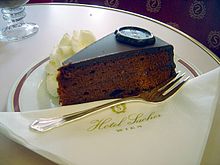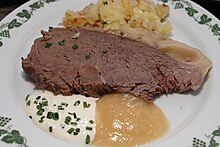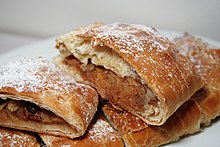Viennese cuisine
As Viennese cuisine is defined as the cooking and eating traditions of the Austrian capital Vienna .
history
Viennese cuisine has different origins. The Italian influence since around 1600 can be seen in the names of ingredients and dishes that are still in use today: Risibisi (Venetian risi e bisi ), aubergine , chestnuts , or biscuit (ladyfingers). In the 18th century, French influence began to prevail - analogous to French etiquette and language in diplomacy, and so the name “ bouillon ” became common in middle-class circles for soup.
At the end of the 18th century, the term “Viennese cuisine” appeared in German cookbooks for the first time, but it did not really emerge until the following century. The Congress of Vienna met from September 18, 1814 to June 9, 1815 and brought guests from all over Europe to the k. u. k. Residential city. No effort was spared to entertain the delegates royally and to entertain them with music and dance. The word about Vienna as a culinary metropolis quickly spread. With the rise of the bourgeoisie, in addition to the courtly food culture, the so - called home-style food developed. “Anyone who was self-conscious employed a cook who mastered the sometimes elaborate recipes of home-style home cooking and was also able to prepare a representative meal if required "Die Süddeutsche Küche" by Katharina Prato , published in Graz in 1858 - was one of the first cookbooks that included Hungarian, South Slavic, Polish, Italian, Jewish and Bohemian elements in addition to Austrian and especially Viennese cuisine. At the end of the 19th century, a cookbook had a decisive influence: “Die Österreichische Küche” by Marie von Rokitansky from Vienna , published in 1897. The author had collected and repeatedly tried out a large number of recipes. In addition to the urban dishes, she also included a number of rural recipes in her book.

Traditional Viennese cuisine is shaped by the earlier influences of immigrants from the regions and countries of the Austro-Hungarian monarchy. Due to the city's location near the border with Hungary, Bohemia and Moravia, dishes from these countries are mainly on the menus. Goulash comes with its Viennese variants - the Viennese, Fiaker and Gypsy goulash - and the strudel , whose wafer-thin, hand-drawn dough was taken from the eastern Mediterranean, probably came to Austria via Hungary . Certain pastries in particular came from Bohemia , such as various golatschen and the term pancakes for pancakes .
Although Austria is now a landlocked country , the fish market in Vienna has a long tradition. The first fish market was set up on Hohen Markt as early as the 14th century . The carp has always been of the greatest importance in Viennese cuisine. The carp peel soup, which later became known as Fischbeuschelsuppe , was prepared from its head, bones, milk and roe . In traditional Viennese inns, it is still a classic Viennese dish, especially at Christmas.
The renewal of gastronomic developments in the recent past in Austria began with the “New Viennese Kitchen”.
Eating habits of the Viennese
According to a study by the AMA ( Agrarmarkt Austria ), the Viennese consume far more ready meals (convenience products) compared to the citizens of the other Austrian federal states, measured on the daily average . The Viennese also visit inns and other restaurants most frequently of all Austrians to satisfy their hunger. In an AMA study, 45% said they ate out once a week. In the past, lunch was the main meal of the day for many, nowadays food intake is mostly spread over the whole day in the form of so-called "snacking" (often with fast food ), or the main meal is increasingly consumed in the evening.
Then as now, the Wiener Schnitzel is very popular. It is a breaded, baked veal schnitzel that is often served with potato salad in Viennese restaurants . The "lard baked" (veal carbon needles, brain, liver, etc.) were typical Viennese dishes that can be found in Viennese cookbooks as early as the 18th century. As early as 1843/44, the children of Archduchess Sophies Franz (who later became Emperor Franz Joseph) and Ferdinand Max (who later became Emperor Maximilian of Mexico) liked to eat the new schnitzel. The Wiener Schnitzel was invented in the first half of the 19th century under different influences and based on a combination of the then developing cooking techniques of schnitzels, breading and frying in the preparation of veal. But the term "Wiener Schnitzel" also found its rapid dissemination from 1850 onwards, initially in German-language cookbooks outside of Austria, while it was not found in cookbooks by Austrian authors until 1893. Potato salad is usually served as a side dish . In addition, the cheaper and most common variant is the Viennese pork schnitzel .
The specialties on the menu include boiled beef with grated horseradish (mixed with apples or bread rolls), small boiled boiled potatoes and often spinach. In addition to traditional Viennese cuisine, the menus also include dishes from other federal states, such as Salzburger Nockerln , Tiroler Gröstl or Carinthian cheese noodles .
The cityscape of Vienna includes the sausage stands in lively areas , where various hot sausages can be bought as snacks. In addition to the Frankfurters , who are mostly known outside of Austria as "Wiener", the Burenwurst ( Burnheitl "Burenhaut", also Haaße "Heiße") and the Käsekrainer (jokingly "Eitrige") are among the most popular varieties. If desired, they can be served with pickles , pickled peppers , sweet or spicy mustard and a slice of bread or a roll as a side dish. The standard range of each hot dog stand also include the meatloaf . As an alternative to the hot dog , the Bosna , which is filled with a small bratwurst, is often offered.
In winter you can buy roasted chestnuts , roasted potatoes , potato pancakes and sometimes roasted almonds from the chestnut roasters (small stalls with a roasting oven) on lively street corners .
In the past decades, Italian restaurants, pizzerias and Chinese restaurants of various levels have found a wide audience in Vienna . In recent years, Asian cuisine has been joined by Japanese and Indian restaurants, and finally also Thai and Vietnamese restaurants. There are also a large number of restaurants with dishes from all over the world, from the Balkans to Greece and the Levant to the cuisines of Africa and South America. The sausage stands faced competition from international fast food franchisers and kebab stands.
Typical dishes of Viennese cuisine
Cold kitchen
Soups
|
Meat and fish dishes
- Tafelspitz with apple or bread roll , chive sauce and dill cream beans
- Schnitzel traditional veal (otherwise with the addition of pork or turkey or chicken ) with potato salad
- Butter schnitzel with parsley potatoes
- In addition to the Viennese juice goulash, various variants such as the Fiaker goulash or Würschtl goulash
- Beuschel (Lunge) (also Salonbeuschel )
- baked liver with potato salad
- Old Viennese onion roast with fried potatoes
- Vanilla roast (vanilla stands for garlic)
- Girardi Rostbraten
- Anchovy roast
- Stephanie roast
- Roast pork with bread dumplings and sauerkraut
- Roast caraway
- Selchfleisch ( Kassel ) with sauerkraut and dumplings
- Frankfurter (The traditional Viennese sausage stand offers other sausage specialties, such as Käsekrainer , Debreziner , Burenwurst , ...)
- baked carp milchner
Pasta dishes, meatless dishes
Pastries

- Kaiserschmarrn
- Powidltascherln
- Bundt cake
- Curd strudel in vanilla sauce
- Milli cream strudel
- Yeast dumplings
- apricot dumplings
- Apple strudel
- Pancakes
- Sachertorte
- donuts
additional
- powidl
- As a typical seasoning side dish, various horseradish varieties: bread roll, horseradish, apple horseradish
- Manner cuts
- Plum stew , a kind of coarse plum compote
See also
literature
- Albert Kofranek: The good Viennese cuisine.
- Adolf and Olga Hess, Peter Kirischitz: Viennese cuisine. ISBN 3-902397-26-8 .
- Franz Maier-Bruck : The Great Sacher Cookbook. Austrian cuisine. Vienna, Munich, Gütersloh u. a. 1975 ISBN 3-929626-27-6 . (Various editions)
- Franz Maier-Bruck: Classic Austrian cuisine , Seehamer Verlag GmbH, Weyarn, 2003, ISBN 3-932131-98-3
- Eva Deissen (ed.): Neue Kronen Zeitung Kochbuch , Verlag Carl Ueberreuter , Vienna 1991, with recipes by Reinhard Gerer (Vienna), Eva Salomon (Lower Austria), Walter Eselböck (Burgenland), Willi Halder (Styria), Karl Eschlböck (Upper Austria ), Karl and Rudolf Obauer (Salzburg), Sissy Sonnleitner (Carinthia), Hasi Unterberger (Tyrol), Ernst and Heino Huber (Vorarlberg), with photos by Peter Lehner
- Eduard Mayer et al. a .: Viennese desserts. 11th edition. Trauner, 2002, ISBN 3-85320-359-0 .
- Herwig Gasser / Petra Schmidt: New Viennese pastries . 3. Edition. Agens Ketterl, 2006, ISBN 3-85134-014-0
- Andreas Wojta : My Viennese cuisine . D + R Verlagsgesellschaft, Vienna 2007, ISBN 3-902469-11-0
- Ewald Plachutta , Mario Plachutta: Plachutta-My Viennese cuisine . Brandstätter, Vienna 2008, ISBN 3-85033-213-6
- Ingrid Haslinger: The Viennese cuisine. Cultural history and recipes. Mandelbaum, Vienna 2018, ISBN 978385476-558-5
Web links
Individual evidence
- ↑ a b Thomas Kahler: Meal! , November 10, 2015, accessed October 10, 2010
- ^ Fish market - history of the Viennese markets
- ↑ Chronicle: Shopping, Cooking, Preserving . In: Die Presse , May 14, 2005 - diepresse.com and diepresse.com
- ↑ Austria's culinary heritage: Favorite dishes of the Viennese , accessed on December 7, 2017






